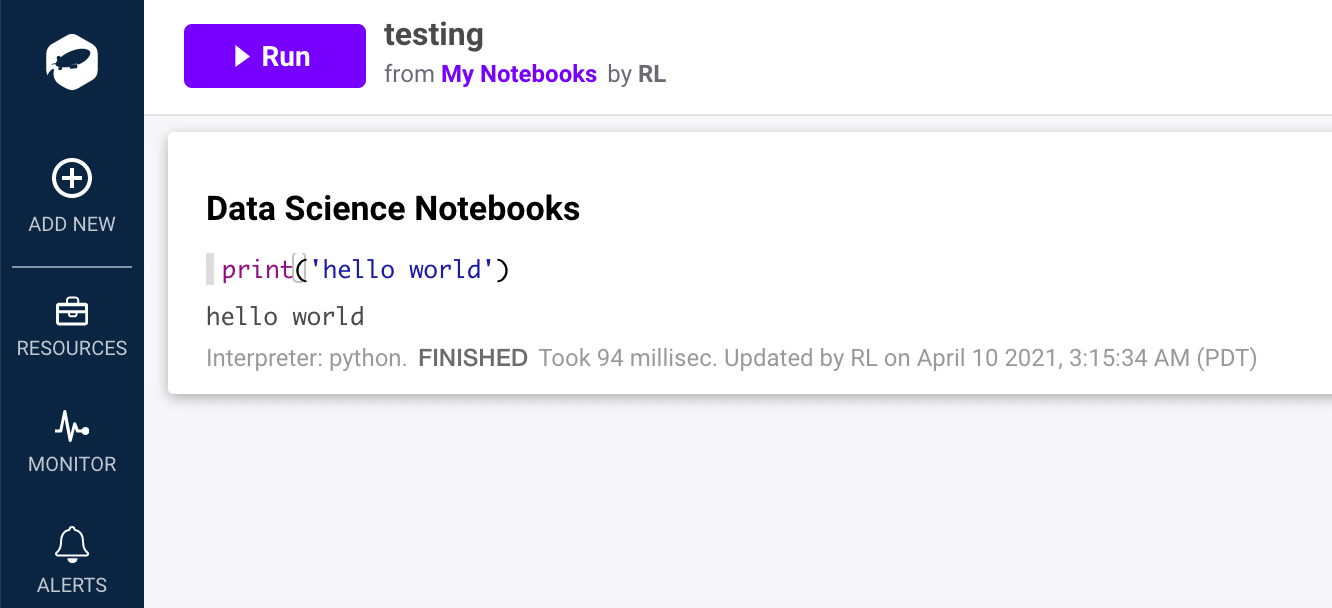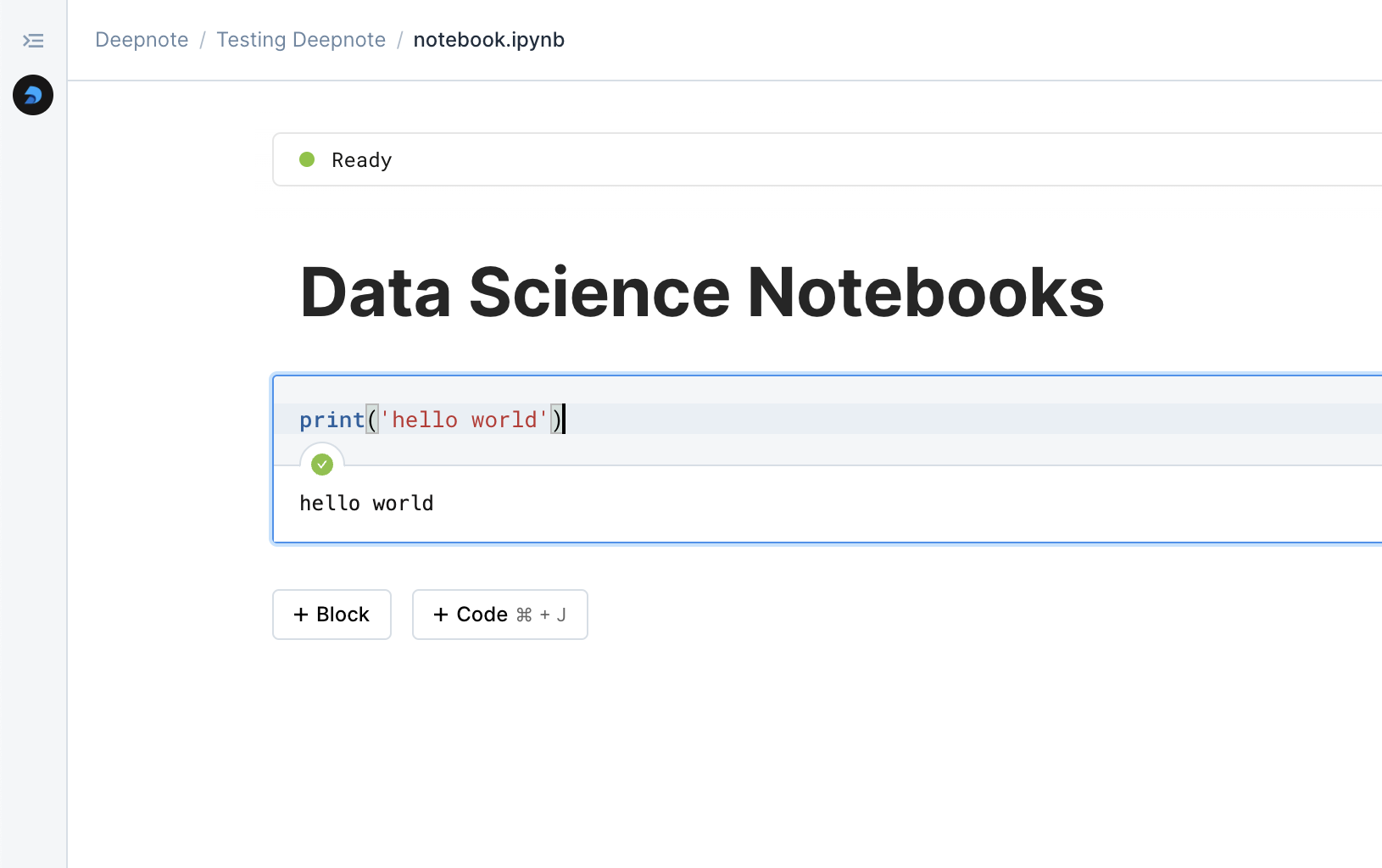

Zepl

Comparing two data science notebooks.






The landscape of collaborative data science platforms continues to evolve, with Zepl and Deepnote representing different approaches to modern analytical workflows. While both platforms aim to enhance data science collaboration and productivity, they each bring unique perspectives and capabilities to address the challenges of modern data teams.
Zepl, now part of DataRobot, was built with enterprise data science needs in mind, focusing on seamless integration with existing data infrastructure and enterprise security requirements. The platform emphasizes production-ready analytics and machine learning workflows, particularly in enterprise contexts.
Deepnote approaches data science collaboration with a modern, cloud-native perspective, emphasizing real-time collaboration and accessibility while maintaining professional-grade features. The platform focuses on creating an environment where data teams can work together seamlessly while leveraging cutting-edge tools and integrations.
The development experience in Zepl reflects its enterprise origins. The platform provides robust support for multiple programming languages and frameworks, with particular attention to enterprise-grade security and scalability. Its integration with DataRobot enhances its automated machine learning capabilities, making it particularly valuable for organizations looking to streamline their ML workflows.
Deepnote offers a more contemporary development experience, with an intuitive interface that combines familiar notebook functionality with modern collaborative features. The platform's real-time collaboration capabilities and integrated AI assistance create an environment that feels natural to modern data teams.
Zepl's enterprise focus is evident in its approach to data integration. The platform provides robust connections to enterprise data sources, with particular attention to security and governance requirements. Its integration with DataRobot's ecosystem enhances its capabilities for handling large-scale data operations and machine learning workflows.
Deepnote takes a broader approach to data integration, offering connections to various modern data sources while maintaining security and performance. The platform's architecture supports both traditional enterprise data sources and modern cloud-based services, providing flexibility for diverse team needs.
The collaborative aspects of these platforms reflect their different approaches to data science workflows. Zepl emphasizes secure collaboration within enterprise environments, with features designed to maintain data governance and compliance while enabling team cooperation.
Deepnote's collaboration features feel more dynamic, with real-time editing capabilities and immediate feedback loops. The platform's design facilitates spontaneous collaboration while maintaining the structure needed for professional data science work.
Zepl's integration with DataRobot provides powerful automated machine learning capabilities, making it particularly strong for organizations looking to streamline their ML workflows. The platform offers sophisticated model development and deployment features, with emphasis on enterprise-scale operations.
Deepnote approaches machine learning through a more flexible lens, providing the tools and environment needed for custom ML development while integrating with popular frameworks and libraries. The platform's AI assistance helps accelerate development while maintaining control over the ML process.
Zepl's enterprise focus makes it particularly suitable for:
Deepnote finds its strength in serving:
The learning curve for Zepl tends to be steeper, reflecting its enterprise features and integration with DataRobot's ecosystem. The platform requires understanding of enterprise data architectures and security protocols, making it more suitable for experienced teams.
Deepnote maintains a more gradual learning curve while offering advanced features. Its intuitive interface and modern design make it accessible to new users while providing the depth needed for professional work.
Zepl's workflow emphasizes structure and security, with clear processes for development, deployment, and collaboration. The platform's enterprise focus shapes how teams interact and manage their projects, with particular attention to governance and scalability.
Deepnote's workflow feels more fluid, encouraging spontaneous collaboration while maintaining professional standards. The platform's real-time features and modern interface facilitate natural team interaction while supporting structured development processes.
Both platforms continue to evolve, with Zepl leveraging its position within the DataRobot ecosystem to enhance its enterprise ML capabilities, while Deepnote expands its collaborative features and integration options to serve modern data teams.
The decision between Zepl and Deepnote often comes down to organizational context and specific needs. Organizations heavily invested in enterprise infrastructure and automated ML might find Zepl's approach more aligned with their requirements. Its integration with DataRobot and focus on security make it particularly valuable for enterprise contexts.
Teams prioritizing modern collaboration features and flexibility might find Deepnote more suitable. Its combination of professional-grade features with contemporary design and real-time collaboration creates an environment well-suited to modern data science workflows.
Zepl and Deepnote represent different perspectives on collaborative data science platforms. Zepl excels in enterprise environments where security, governance, and automated ML are priorities. Its integration with DataRobot provides powerful capabilities for organizations looking to scale their ML operations.
Deepnote offers a more modern, flexible approach to data science collaboration, emphasizing real-time interaction and accessibility while maintaining professional capabilities. Its design and features make it particularly valuable for teams embracing contemporary development practices.
The choice between these platforms should align with your organization's specific needs, existing infrastructure, and team dynamics. Understanding these distinctions helps ensure you select the platform that best supports your data science objectives while providing the necessary tools for team success.